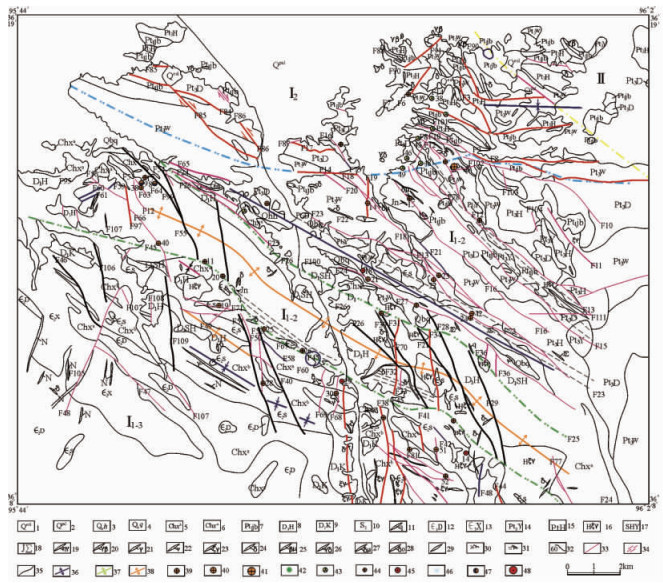SPECTRAL CHARACTERISTICS OF ALTERATION MINERALS AND ITS APPLICATION IN GOLD DEPOSIT PROSPECTING IN WULONGGOU, QINGHAI PROVINCE
-
摘要: 使用近红外光谱仪对五龙沟金矿区主要蚀变矿物进行了光谱测试,获得该矿区主要蚀变矿物的光谱数据;同时选择部分具有代表性的样品进行详细的镜下鉴定,并将镜下鉴定结果与野外实测光谱曲线进行对比分析,检查其对五龙沟金矿体矿化蚀变快速检测的有效性和准确度。对比分析结果表明,蚀变分带与矿体吻合较好,对矿化分带具有较好的指示意义,也为该区的金矿勘探提供了依据。Abstract: Near-Infrared Spectrometer was used to investigate main alteration minerals in Wulonggou gold deposit and got their spectroscopic data. The typical samples were chosen for detailed microscopic identification, and the result was compared with the filed spectrometer curve. The efficiency and accuracy of gold deposit alternation fast investigation was checked. The analysis showed alteration zonation was well in accord with ore body, had a better guidance for mineralization, and supplied dependence for gold deposit exploration.
-
Key words:
- spectrum curve /
- alteration mineral /
- Wulonggou gold deposit
-
图 1 五龙沟金矿矿区地质简图(陆露,2011;据五龙沟金矿内部研究报告修编,2008)
1—第四系风成砂;2—第四系冲洪积砂、砾石层;3—青白口系变火山岩组;4—青白口系丘吉东沟组;5—长城系小庙组上段;6—长城系小庙组下段;7—下元古代白沙河岩组;8—泥盆纪侵入岩-淡肉红色中粗粒黑云母钾长花岗岩;9—泥盆纪侵入岩-灰-浅灰色中粗粒二长花岗岩;10—晚志留纪侵入岩;11—晚志留纪-晚泥盆纪侵入岩;12—寒武纪侵入岩-浅灰中粗粒二长花岗岩;13—寒武纪侵入岩-浅灰黑云母花岗闪长岩;14—晚元古代侵入岩-浅灰中粗粒黑云母花岗闪长岩;15—晚元古代侵入岩-灰色中细粒石英闪长岩;16—肉红色中粒强蚀变钾长花岗岩;17—深灰绿色中粒硅化角闪辉长石;18—尖黑山单元:灰绿色透闪石化橄辉岩;19—二长花岗岩脉;20—黑云母花岗岩脉;21—石英脉;22—花岗岩脉;23—钾长花岗岩脉;24—闪长岩脉;25—辉绿玢岩脉;26—辉石闪长岩脉;27—闪长玢岩脉;28—石英闪长岩脉;29—岩脉;30—岩层产状;31—岩石片理产状;32—岩石片麻理产状;33—断层;34—韧性剪切带;35—地层界线;36—背斜轴迹;37—倒装向斜轴迹;38—向斜轴迹;39—小型金矿床位置;40—中型金矿床位置;41—大型金矿床位置;42—铜金属矿化位置点;43—多金属矿化位置点;44—金矿化点;45—铁矿化位置点;46—钼矿化位置点;47—多金属矿点;48—铅锌矿点位
Figure 1. Geological sketch map of WuLonggou gold deposit
-
[1] 李厚民, 钱壮志, 胡正国, 等.青海省都兰县五龙沟地区金矿化类型[J].青海地质, 1999, (1):36~41. http://www.cnki.com.cn/Article/CJFDTOTAL-GTJL199901006.htmLI Hou-min, QIAN Zhuang-zhi, HU Zheng-guo, et al. Type of gold mineralization in Wulonggou area, Qinghai[J]. Qinghai Geology, 1999, (1):36~41. http://www.cnki.com.cn/Article/CJFDTOTAL-GTJL199901006.htm [2] 田国强, 朱多禄, 田咏.五龙沟铜锌矿地质成因探讨[J].甘肃冶金, 2006, 28(3):63~65. http://www.cnki.com.cn/Article/CJFDTOTAL-GSYE200603025.htmTIAN Guo-qiang, ZHU Duo-lu, TIAN Yong. Genetic discuss of Cu-Zn deposit of Wulonggou[J]. Gansu Metallurgy, 2006, 28(3):63~65. http://www.cnki.com.cn/Article/CJFDTOTAL-GSYE200603025.htm [3] 袁万明, 莫宣学, 喻学惠, 等.东昆仑印支期区域构造背景的花岗岩记录[J].地质论评, 2000, 46(2):203~211. http://www.cnki.com.cn/Article/CJFDTOTAL-DZLP200002012.htmYUAN Wan-ming, MO Xuan-xue, YU Xue-hui, et al. The record of Indosinian tectonic setting from the granotoid of eastern Kunlun Mountains[J]. GeologicalReview, 2000, 46(2):203~211. http://www.cnki.com.cn/Article/CJFDTOTAL-DZLP200002012.htm [4] 钱壮志, 胡正国, 刘继庆.东昆仑北西向韧性剪切带发育的区域构造背景:以石灰沟韧性剪切带为例[J].成都理工学院学报, 1998, 25(2):201~205. http://www.cnki.com.cn/Article/CJFDTOTAL-CDLG802.014.htmQIAN Zhuang-zhi, HU Zheng-guo, LIU Ji-qing. Northwest ductile shear zones and their tectonic setting in the east of Kunlun Mountains:Take Shihuigou ductile shear zone as an example[J]. Journal of Chengdu University of Technology, 1998, 25(2):201~205. http://www.cnki.com.cn/Article/CJFDTOTAL-CDLG802.014.htm [5] 寇林林, 罗明非, 钟康惠.青海五龙沟金矿矿集区Ⅰ号韧性剪切带40Ar/39Ar年龄及地质意义[J].新疆地质, 2010, 28(3):330~333. http://kns.cnki.net/KCMS/detail/detail.aspx?filename=xjdi201003023&dbname=CJFD&dbcode=CJFQKOU Lin-lin, LUO Ming-fei, ZHONG Kang-hui. 40Ar/39Ar dating of theⅠgold-bearing shear zone on the gold-ore collected belt of the Wulonggou, Qinghai, and its significance[J]. Xinjiang Geology, 2010, 28(3):330~333. http://kns.cnki.net/KCMS/detail/detail.aspx?filename=xjdi201003023&dbname=CJFD&dbcode=CJFQ [6] 高香香, 邹林, 高光明, 等.青海五龙沟地区1:5万遥感信息找矿勘查与靶区预测研究[J].矿产与地质, 2005, 19(4):418~421. http://www.cnki.com.cn/Article/CJFDTOTAL-KCYD200504017.htmGAO Xiang-xiang, ZOU Lin, GAO Guang-ming, et al. 1/50000 scale remote sensing prospecting and target prediction in Wulonggou area, Qinghai[J]. Mineral Resources and Geology, 2005, 19(4):418~421. http://www.cnki.com.cn/Article/CJFDTOTAL-KCYD200504017.htm [7] 刘刚.东昆仑五龙沟金矿围岩蚀变的遥感识别[J].国土资源遥感, 2002, 54(4):60~62. doi: 10.6046/gtzyyg.2002.04.13LIU Gang. Remote sensing extraction of alteration information related to the Wulonggou gold deposit, East Kunlun Mountains[J]. Remote Sensing for Land &Resources, 2002, 54(4):60~62. doi: 10.6046/gtzyyg.2002.04.13 [8] 张廷斌, 钟康惠, 易桂花, 等.东昆仑五龙沟金矿集中区遥感地质信息提取与找矿预测[J].地质与勘探, 2009, 45(4):444~449. http://www.cnki.com.cn/Article/CJFDTOTAL-DZKT200904016.htmZHANG Ting-bin, ZHONG Kang-hui, YI Gui-hua, et al. The extraction of remote sensing geological information and metalllogeneic prediction of gold mineralized concentrate district in Wulonggou, East Kunlun Mountains[J]. Geology and Exploration, 2009, 45(4):444~449. http://www.cnki.com.cn/Article/CJFDTOTAL-DZKT200904016.htm [9] 易桂花, 张廷斌, 倪师军, 等.五龙沟金矿集中区化探异常与遥感蚀变异常的综合分析[J].中国矿业, 2010, 19(12):104~106. doi: 10.3969/j.issn.1004-4051.2010.12.031YI Gui-hua, ZHANG Ting-bin, NI Shi-jun, et al. Comprehensive analysis of geochemical anomaly and remote sensing alteration of gold mineralized concentrate district in Wulonggou area[J]. China Mining Magazine, 2010, 19(12):104~106. doi: 10.3969/j.issn.1004-4051.2010.12.031 [10] 邹长毅, 史长义.五龙沟金矿区域地球化学异常特征及找矿标志[J].中国地质, 2004, 31(4):420~423. http://www.cnki.com.cn/Article/CJFDTOTAL-DIZI200404012.htmZOU Chang-yi, SHI Chang-yi. Characteristics of regional geochemical anomalies and ore indications in the Wulonggou gold deposit[J]. Geology in China, 2004, 31(4):420~423. http://www.cnki.com.cn/Article/CJFDTOTAL-DIZI200404012.htm [11] 钱壮志, 李厚民, 胡正国, 等.东昆仑中带闪长玢岩脉与金矿成矿关系-以石灰沟金矿床为例[J].西安工程学院学报, 1999, 21(1):1~4. http://www.cnki.com.cn/Article/CJFDTOTAL-XAGX901.000.htmQIAN Zhuang-zhi, LI Hou-min, HU Zheng-guo, et al. The relationship between the dioritic porphyrite dikes and the gold mineralization in the middle belt of East Kunlun Mountains[J]. Journal of Xi'an Engineering University, 1999, 21(1):1~4. http://www.cnki.com.cn/Article/CJFDTOTAL-XAGX901.000.htm [12] 钱壮志, 李厚民, 胡正国.青海五龙沟地区金矿控矿构造研究[J].西安地质学院学报, 1997, 19(增刊):27~32. http://www.cnki.com.cn/Article/CJFDTOTAL-XAGX1997S1004.htmQIAN Zhuang-zhi, LI Hou-min, HU Zheng-guo. Study of structures controlling gold deposits in Wulonggou areas, Qinghai Province[J]. Journal of Xi'an College of Geology, 1997, 19(Supp.):27~32. http://www.cnki.com.cn/Article/CJFDTOTAL-XAGX1997S1004.htm [13] 李厚民, 沈远超, 胡正国, 等.青海东昆仑五龙沟金矿成矿条件及成矿机理[J].地质与勘探, 2001, 37(1):65~69. http://www.cnki.com.cn/Article/CJFDTOTAL-DZKT200101014.htmLI Hou-min, SHEN Yuan-chao, HU Zheng-guo, et al. Minerogeneticme and condition of Wulonggou gold deposit in East Kunlun Mountains, Qinghai Province[J]. Geology and Prospecting, 2001, 37(1):65~69. http://www.cnki.com.cn/Article/CJFDTOTAL-DZKT200101014.htm -





 下载:
下载:





